Month: November, 2006
Durango and late night Momofuku
Left the Financial District at lunchtime to meet SYB at the Public Theater box office — my second time there in just under a week. As part of a special promotion, the theatre was offering same-day tickets to their new production of Julia Cho’s Durango for just $10 on Thursdays. The play officially opens on November 20.
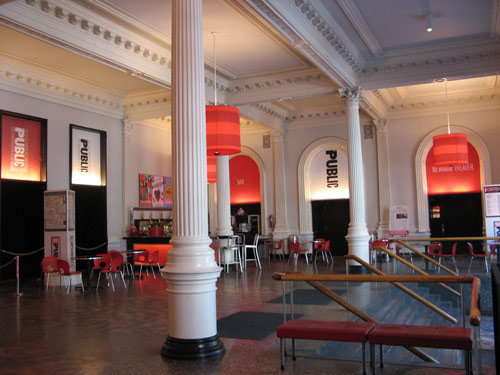
It was a brilliantly sunny day, and after picking up our three tickets for later tonight, we scored a table just outside the entrance to Cooper Union’s Engineering Building (where my crochet class was held this summer) and broke into the pulled pork tacos SYB had brought with him from the Vendley brothers “Calexico” cart in SoHo.
I felt like a woman of leisure, lounging at an outdoor table in the mid-afternoon, watching the world pass by. I continued the illusion by taking a brief post-lunch stroll along St. Mark’s Place, recalling all the while the street’s much grittier past.
Case in point: a new CBGB store “comin soon”? Sharing space with — no lie — a Chipotle? (Last month, a new BCBG store opened up a block from my apartment — very different, for the dyslexic/careless readers among you.) Does the slide from punk legend to sell-out — complete with a possible move to Vegas — really take only one month? Just further evidence of the East Village’s degeneration into the amusement park version of itself. Good grief.
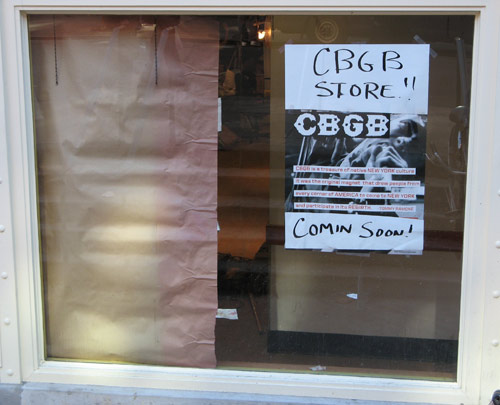
Farther down on St. Mark’s, we popped into Bamn — the Japanese take on 1950’s automats. Trippy, to be sure, and one senses that Bamn’s target diner is not an office worker on her lunch break: hot pink plastic and too bright lights, with a dancebeat soundtrack piped in. There is no seating, and the retro-futuristic space is dominated by a coin-operated vending wall with heated, see-through compartments, behind which sits a working kitchen. There’s also a fry-station, this afternoon manned by a real live, disaffected-looking Japanese hipster. Menu items slant toward American fast food classics with a Japanese twist, and cost only $1.50-$2.50. The selection, though, is pause (and possibly indigestion)-inducing: Teri burgers, hot dogs, PB & J and grilled cheese sandwiches, fried chicken, Spam musubi-teriyaki, pizza dumplings, chicken pot pie croquettes. I couldn’t resist sampling the mac and cheese croquettes… because I was still a little hungry, and a lot curious. Not terrible… for $2.00, that is.
Bamn is open “25 hours a day.” Rightly so.
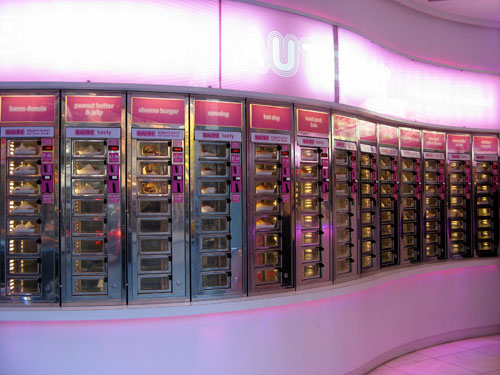
After work, we reconvened in SoHo for the Nancy Koltes at Home re-opening reception. The shop, which deals in high-end bedding, bath products, entertaining accessories and loungewear, recently expanded into the adjacent storefront. I examined the wares while indulging in some prettily dainty bites with elegant sparkling drinks, sprinkled with edible gold-leaf.
SYB, I think, found the environs a bit too effete (or perhaps the wafting scents within, a bit too overpowering) — so we collected our scented soap-stuffed gift bags before decamping across the street for the decidedly less rarified airs of Lombardi’s.
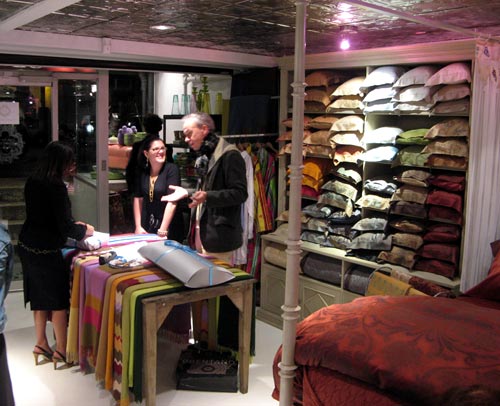
Despite a few transportation snafus, CS just made it to the theater just in time for Durango curtain time. We sat back and watched the story unfold of a widowed father who embarks on a spontaneous family road trip through the Southwest with his two sons. Along the way, there are flashbacks, fights and life-shattering secrets. The conceit is familiar, and according to SYB, so was the portrayal of some Korean-American family dynamics: the mixture of pride and shame, the guilt, the blame, the screaming recrimations. He spent a good part of the play muttering, “Just like my Sunday nights.” There wasn’t much for me to say in response.
The talented cast of five featured James Saito as the father, James Yaegashi and Jon Norman Schneider as his sons, and Ross Bickell and Jay Sullivan in smaller roles.
After the play, our trio took a leisurely stroll over to sample the late night menu at Momofuku Ssäm Bar. I’d been to the restaurant when it first opened — also after a performance at the Public — and had enjoyed the pork buns and ssäms then, but in its review two months later, the New York Times alerted me to the newly added, and now not-so-secret special late night menu:
Five nights a week, after the ssam bar closes, a spirited cast of chefs — Mr. [David] Chang, Mr. [Joaquin] Baca, Tien Ho, formerly of Cafe Boulud, and Joshua McFadden, late of Lupa — run a restaurant in a restaurant that goes far to explain the venture.
Most chefs working the witching hour offer abbreviated menus. Here, that equation is flipped with diverse, carefully crafted dishes, from fried cauliflower chat ($9) to spicy tripe stew ($11), emerging late. The restaurant’s transformation, which includes table service, a thumping kitchen and some well-paired beer and sparkling wine options, is as intriguing as watching a strait-laced wallflower reveal an inner wild child.
You knew we were going to have to check this out.
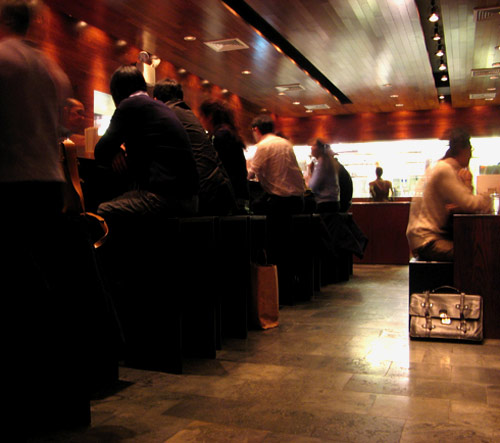
The late night menu, which starts at 10:30PM, already seems to have developed its own following. We arrived about 15 minutes early to find a short queue already forming on Second Avenue outside the closed restaurant door. At promptly half past, the doors opened and we were seated.
This time, it was an altogether different dining experience than the last. There was the attentive table service for starters, and a more varied menu this time around: those wonderful pork buns made the cut (but not the ssäm), plus a raw bar and a tempting list of small plates for sharing, with selections ranging from local produce and artisinal cheeses to spicy tripe, grilled sweetbreads and veal head.
We were somewhat less adventurous this evening, but were still served well by our selections. There was the simply titled “Bread & Butter” to start: fresh toasted bread with Vermont salted and English goat’s butters. The “Steamed Buns,” of course. And here, the “Seasonal Pickles”…
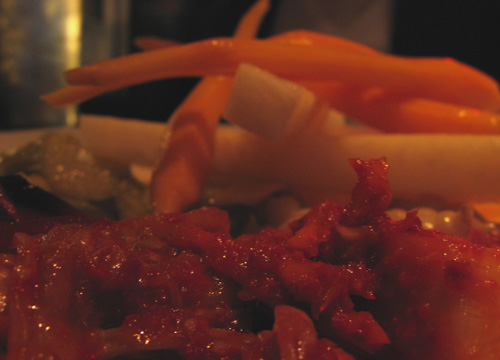
…the ‘Mutsu and Macoun Apple Kimchi” with crispy pork jowl and arugula…
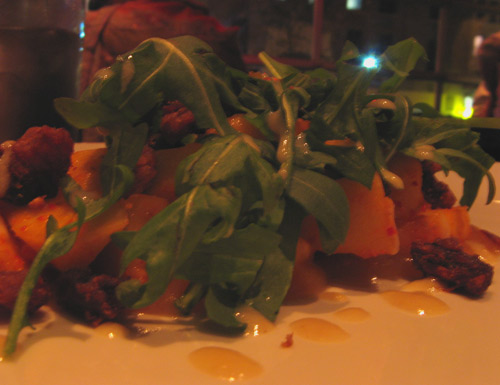
…the “Roasted Hanger Steak,” accompanied by arugula and cubes of hash-brown-like “rice fries”…
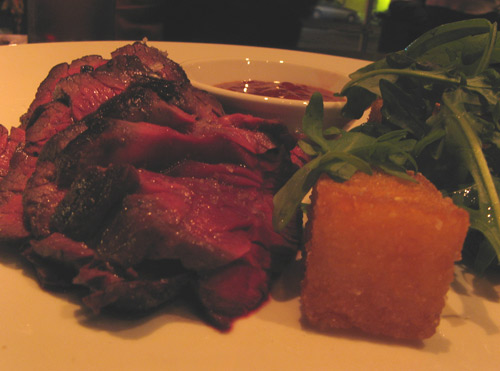
… and one of three platters of paper-thin sliced ham, served with toasted bread and apple butter — offered under the menu heading of “Pork.” What a delightful end to a full day.
Chef Chang was in the kitchen this night, as he was the last time — which makes me wonder just how much time he spends at his Noodle Bar.
Horton sees a Pollock
I attended the New York premiere for Harry Moses’ new documentary, “Who the #$&% is Jackson Pollock?” at the IFC Center.
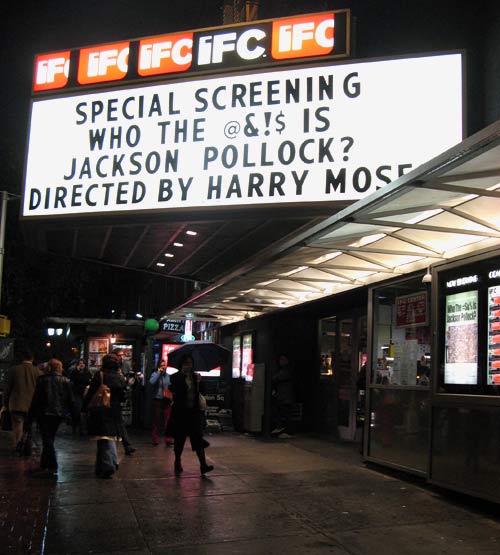
It tells the fascinating, often hilarious, story of retired long-haul truck driver Teri Horton, who has in her possession a 66″ x 48″ paint-splattered canvas which she bought as a gag for a friend, that may be an original Jackson Pollock painting worth tens of millions of dollars. That is, if it can be certified as a genuine Pollock, which it currently cannot.
In 1992, Horton picked up the painting in question at a San Bernadino thrift shop for $5 — she refused to pay $8 — and then lugged it to her friend’s mobile home in the flatbed of her truck. The friend got a big laugh out of the hideous present, but turned it down because it barely fit through her trailer door. The painting went into storage, and was later hauled out for a yard sale where it was spied by a local art teacher, who advised Horton that the painting bore a remarkable resemblance to work by the leading 20th Century American artist, Jackson Pollock. Horton’s response (in its uncensored form) gives the film its title.
What followed was an arduous quest to authenticate the unsigned, provenance-less painting, fleshed out by a colorful cast of mostly condescending and dismissive art world establishment players (former Metropolitan Museum of Art director Thomas P.F. Hoving comes off particularly insufferable, snooting remarks like “She knows nothing. I am an expert.”), wealthy dealers and businessmen, a master art forger, a slick-talking convicted felon, a Quebecois forensic investigator, guitar-strumming, cowboy-hatted friends and relatives and at the center of it all: a fiesty mid-septuagenarian with a whisky and cigarettes voice and a mouth like a sailor. New York Times writer Randy Kennedy explores the long, strange trip of Horton and her painting in a story that appeared on the front page of the Arts section the next day.
Director Moses and father and son producers Don and Steven Hewitt were also in attendance at the premiere, as were many of they key figures of the film. Horton included — along with her four grown children who, we were told that night, all met for the first time over the previous weekend. (One senses, and the film alludes to it briefly, that Horton has had a long and troubled life.) Hoving declined the invitation.
Don Hewitt, best known as creator and longtime executive producer of 60 Minutes, with Horton:
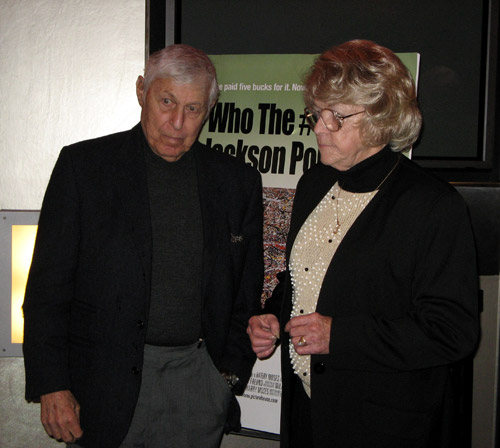
What struck me about the film, beside the fantastically improbable story, was how Horton has adopted the painting as her raison d’être. Early into the process, Horton turned down $2 million for the unauthenticated painting, much to the dismay of her family. She continued to doggedly pursue the matter, but despite additional evidence (including the discovery by forensic art expert Peter Paul Biro of a fingerprint in paint on the back of her canvas, matching one found in Pollock’s East Hampton studio), the established art world still refused to validate her Pollock… and perhaps by extension, outsider Horton.
The film’s closing credits reveal that Horton was offered $9 million for her painting by a Dubai art collector. She turned it down, flat — eliciting groans of disbelief from the audience. Horton continues to live in her humble Costa Mesa home, collecting social security checks. Clearly much more than the money is at stake here: at this stage in her life, $9 million is the same as $50 million. Horton, however, refuses to rest until the “experts” acknowledge her painting, or she is able to sell her painting for an “appropriate” and worthy sum.
Is it a Pollock? Is Horton a fool?
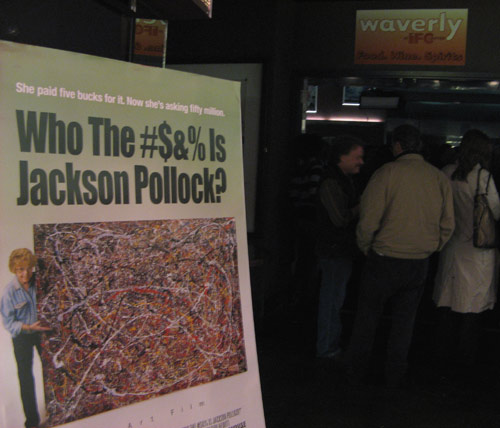
The week before the premiere, Sotheby’s reported that Hollywood entertainment magnate David Geffen sold one of Pollock’s earliest drip paintings, “No. 5, 1948“, for $140 million, the highest figure known to have ever been paid for a painting. If confirmed, it would break the record believed to have been set in June when cosmetics magnate Ronald Lauder purchased Gustav Klimt’s 1907 portrait of Adele Bloch-Bauer for a reported $135 million. (The latter was on display as part of an exhibition at New York’s Neue Gallery this summer.)
Pollock’s No. 5, with its intricate web of reds, yellows, blues and greys, was used in the film as a point of comparison with Horton’s. Shown side by side, the canvases were strikingly similar in detail, and Biro’s examination revealed that both have trace surface evidence of fine gold-flecked mist, presumed to be residue from a spraypaint can.
No doubt the number on the price tag in Horton’s head just went up.
Oh, at the afterparty at The Waverly, I was approached by a 60-ish film producer who offered me entrée to the film’s “after afterparty.” I politely declined. I guess I’m holding out for a better offer, too.
Cheese and macaroni
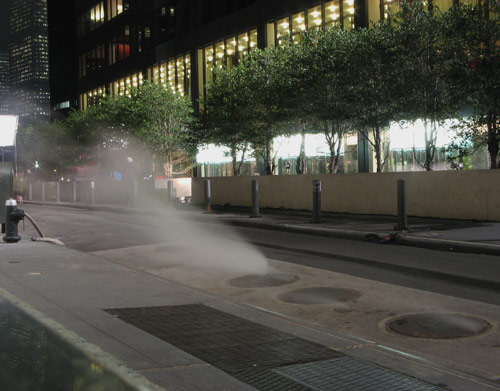
Back at Westville, this time with M. I hauled a canvas bag full of organic vegetables — included in this week’s share: brussels sprouts on the stalk, and the never-ending crop of kale! — and made my way down to West 10th Street through the light drizzle on Seventh Avenue.
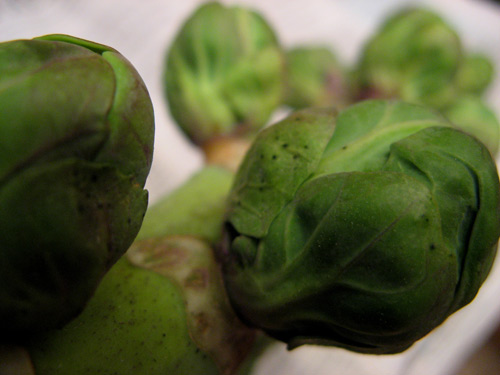
As usual, there was already a small crowd gathered outside the restaurant door, so I promptly wrote my name on the clipboard quaintly hanging from the nail under the awning. M arrived just minutes behind me and together we waited on the sidewalk outside the cozy (read: tiny) restaurant, craning our necks for a glimpse of an opening among the tightly packed wooden tables.
At last we were beckoned inside by one of the slacker waiters. Of course, M and I had to share an order of the smokey mac n’ cheese — this time with bacon. I’ve been a bit obsessed with macaroni and cheese lately, perhaps inspired by my last visit to Westville. By coincidence — or fate — the next morning, NPR featured a piece on the dish’s history and its many varieties. In it, commentator Joseph C. Phillips rails against the “artificial orange lab experiment” that is processed macaroni and cheese.
If I had a million dollars
We wouldn’t have to eat Kraft Dinner
But we would eat Kraft Dinner.
Of course we would: we’d just eat more!— “If I Had $1000000,” Barenaked Ladies — who performed this song, among others, at Radio City Music Hall last night.
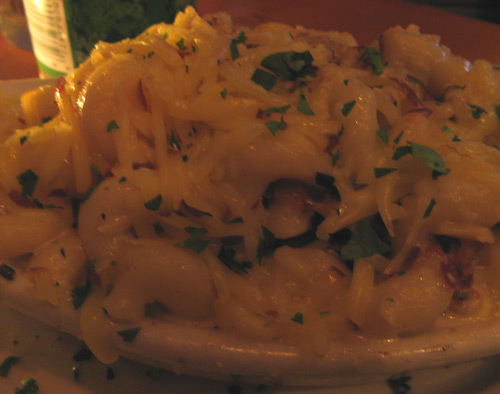
Popular folklore has it that Thomas Jefferson invented macaroni and cheese. The theory has since been discredited, but it’s documented that Jefferson served the dish (made with his preferred imported Parmesan cheese) at the White House in 1802, and American recipes for pasta with cheese can be traced to at least that time period. In The Man Who Ate Everything, lawyer turned food journalist Jeffrey Steingarten describes an 1802 recipe as the “very first recipe ever printed on the back of an American box.” The recipe was, in fact, printed on sheets of paper wrapped around bundles of dried noodles produced at the first American pasta factory in Philadelphia.
The cast iron turkey burger on a Portuguese muffin was supremely solid, as usual: lean, yet juicy, and served with a side of lightly dressed greens and juicy slices of onion and tomato. Best turkey burger in the city.
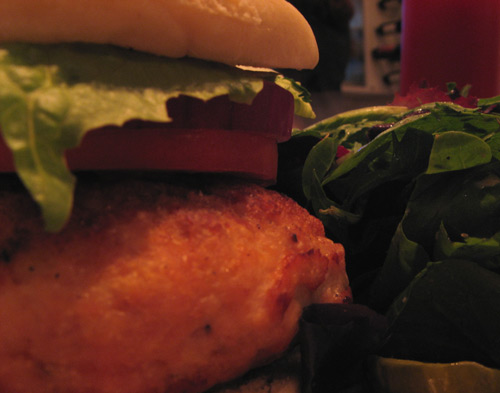
And for dessert: a pair of Westville’s homemade Oreos: hockey puck-sized, soft, chewy dark chocolate cookies spread with vanilla cream.

I’ve yet to investigate, but I’ve read that Bouchon Bakery has its own version of the Keebler treat: the TKO (which stands for “Thomas Keller Oreo,” not “technical knockout”), made with Valrhona cookie wafers sandwiching white chocolate ganache. Mmm.
Search
Popular Tags
Categories
Archive
- July 2010
- July 2009
- January 2009
- November 2008
- September 2008
- August 2008
- July 2008
- June 2008
- May 2008
- April 2008
- March 2008
- February 2008
- January 2008
- December 2007
- November 2007
- October 2007
- September 2007
- August 2007
- July 2007
- June 2007
- May 2007
- April 2007
- March 2007
- February 2007
- January 2007
- December 2006
- November 2006
- October 2006
- September 2006
- August 2006
- July 2006
- June 2006